11/01/2020
After a second dusting of snow, and a week of freezing weather, it became apparent this was the last weekend for winter prep. In years past, living in a city or suburbia, that mostly entailed breaking out the winter clothes and mounting snow tires on the family vehicle. Severe snow storms usually resulted in no on street parking to make room for city snow plows and kids, and maybe parents, spending an unexpected snow day at home.
In rural Maine, it is a bit different. Snow storms could mean isolation from the basic necessities of food shopping, medical care, days without electrical power, and running LP and heating oil to exhaustion. So preparation, to avoid winter apprehension, means a little more planning. Driveway snow markers were placed. The generator received its semi annual maintenance. The snow blowers were serviced and topped off with gas and fuel stabilizer. Jet heaters were moved to the garage. Walkway and roof shovels were spray waxed and stowed by the garage pedestrian door. Propane tanks, fuel containers and oil tanks all topped off, and winter clothes and boots at the ready. All supporting gear is good to go.
The most significant accomplishments? Removing 5,000 cubic feet of winter gear and equipment from a storage shed, inserting 7,000 cubic feet of fair weather landscaping gear and equipment, and still being able to close the doors. Wish my wife and I were snow birds.
Firearm flexibility
My wife and I both like the compact Ruger LC### series. Their compact form is easy to conceal, they are light in weight and provide adequate power for self defense. My wife prefers the LC380 chambered for the 380 Automatic, while I prefer the LC9 chambered for the 9mm Luger.
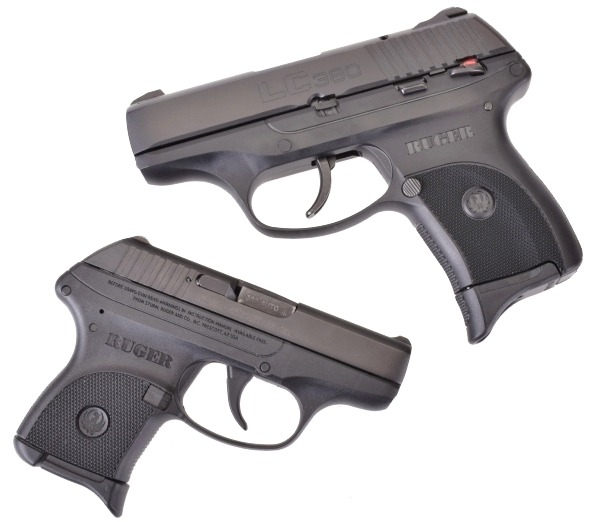
My wife appreciated the LCP, above – bottom, with its even more compact form, but found it too difficult to control and its slide difficult to rack. For me, the LC380 size is right for the application, but I tend to favor 9mm Luger power. Plus, the 9mm Luger cartridge, with five times the number of factory loads of the 380 Auto and it is more commonly available even in times of ammo shortages. So the LC380 was purchased and a Ruger LC9 conversion kit was secured from Shop Ruger.
Not cheap, but a good solution
As outlined extensively, elaborately and exhaustively in the great American novel… not by Philip Roth, “Ruger’s LC380CA Part I“, the LC380CA is a California approved pistol. Left unchanged from its original form, it is hammer fired, not a striker, and still had all of its premium features like sights that are dovetail mounted. The rest of this pistol’s family has gone striker, adapted sights integrated into the slide, and no appear on the California compliance roster. Additionally, there are no LC9s on the California roster and they also have moved to a striker design and adapted integrated sights.
No, the slides below are not disproportionately small for the grip frame. They just fell victim to a short focus lens that increases the size of near objects and diminishes those in the distance. The alternative required the use of a tall ladder, juggling acrobatics and being blinded by electronic flash while extending out over a table. Not pretty. I like you guys a lot, but after consideration…
The LC9 Conversion Kit for LC380® Pistol, Item Number 90499 includes a slide part marked “9mm Conversion”, a 9mm chambered ramped barrel, a guide rod with dual recoil springs, a 9mm magazine, and a user manual. Timed, that change over from one to the other took me twenty seconds. The process is to disassemble as would be routine for cleaning, but reassembling with the 9mm conversion kit parts. No, you don’t have to clean the pistol. That was a comment to establish point of reference. Both pistol and conversion kits are legal in California.
But, Joe, what if I get the slides and barrels mixed up?
I know you. You are the guy who keeps posting on the Real Guns Facebook page that you like spinach, hate my politics and wish I would provide more coverage of Krieghoff three bore drillings.
. In answer to this and the rest of your questions. The slides are caliber marked, the barrels are caliber marked, the magazines are caliber marked, 26 horse power, 160 pounds, Donald Trump. What is I don’t give a monkey’s tail about California ownership? Then you are left with a premium feature version of the LC380 and LC9 sharing a common frame.
What might one do with this combo proposition?
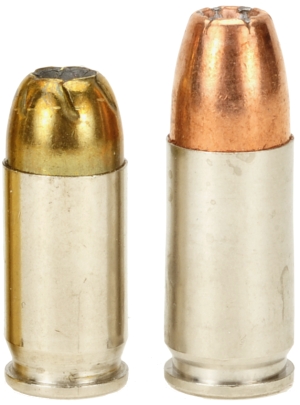 Contrary to appearances, the 380 Auto is not by dimension a 9mm Luger short, even if one of its other names is the 9mm Kurz… which means “short” in German. The 380 has also been assigned the nomenclatures: 9mm Browning Short, 9x17mm and 380 Automatic (SAAMI name of record). The cartridge was designed by John M. Browning and introduced into the Colt Automatic Pocket pistol line as the 380 ACP in 1908. In 1912, the cartridge was introduced by FN for their pocket pistols with the name .380 Browning Short.
Contrary to appearances, the 380 Auto is not by dimension a 9mm Luger short, even if one of its other names is the 9mm Kurz… which means “short” in German. The 380 has also been assigned the nomenclatures: 9mm Browning Short, 9x17mm and 380 Automatic (SAAMI name of record). The cartridge was designed by John M. Browning and introduced into the Colt Automatic Pocket pistol line as the 380 ACP in 1908. In 1912, the cartridge was introduced by FN for their pocket pistols with the name .380 Browning Short.
The 9mm Luger was introduced in 1902 in tandem with the auto loading pistol of the same name. Both cartridges have been adopted by various countries for military and law enforcement issue, both are chambered extensively in civilian firearms, although the 9mm Luger was not chambered in an American firearm until 1954.
The casings are quite different, so the larger 9mm Luger cannot be modified into a 380 Auto casing. the 380 Auto rim is 0.020″ smaller in diameter, the extractor groove is 0.010″ more narrow, the casehead relief angle above the extractor groove is 20°, 15° less acute than the 9mm Luger, and the body ahead of the extractor groove is approximately 0.020″ smaller in diameter.
Essentially, shortening a 9mm Luger case and running it through a 380 Auto sizer die, will not get you there. In the face of a zombie apocalypse, when delivery from your favorite online supplier is slow, the closest approach to parent case to modify is the 223 Remington… and a hacksaw… full length 380 Auto sizer dies… clean up tools… and a lot of patience.
Some people buy ammo. Some people buy components
I don’t like to buy factory ammo, because good ammo is over priced, it takes up a lot of space and it is limited in application. So I buy components in bulk until the floor in the shop sags and handload ammo so I can continue writing and conducting projects even after online retailers and distributors hang a sold out sign on everything.
After many years of mortal combat… Kombat? with gel blocks, blowing up fruits and vegetables and dispatching medium size varmints, I have settled on a narrow selection of bullet for the 380 Auto and 9mm Luger that I hold in reserve for emergencies. Does not mean I don’t ever handload with bullets that look like small rocket ships made on a screw machine, or bullets made of copper dust and bondo. It just means when chips are down; wood, buffalo or off the old block, I have a supply of dependable performing bullets with a supply of supporting material.

Three to the left are for the 380 Auto. Three to the right are for the 9mm Luger. L-R Barnes copper 80 grain TAC-XP, MagTech 85 grain JHP, Remington 102 grain Golden Saber JHP, Sierra 115 grain JHP, Remington 124 grain JHP, Hornady 147 grain XTP JHP. Let’s load some, 380 Auto and 9mm Luger, then put them through the LC380 and with the LC9 conversion in place and see how it goes.
The 380 Automatic… I like that name
Warning: Bullet selections are specific, and loads are not valid with substitutions of different bullets of the same weight. Variations in bullet length will alter net case capacity, pressure and velocity. Primer selection is specific and primer types are not interchangeable. These are maximum loads in my firearms and may be excessive in others. All loads should be reduced by 5% as a starting point for development where cartridges have greater than 40 grains in capacity and 10% for cartridges with less than 40 grain capacity following safe handloading practices as represented in established mainstream reloading manuals. Presentation of these loads does not constitute a solicitation for their use, nor a recommendation.

| 380 Automatic Max 21.5 kpsi MAP |
|
| Firearm | Ruger LC380 |
| Barrel Length | 3.12″ |
| Max Case Length | 0.680″ +0.000″/-0.010″ |
| Min – Max COL | 0.910″ – 0.984″ |
| Primer | CCI 500 – Small Pistol |
| Bullet Diameter | 0.3565″ +0.000″/-0.0030″ |
| Reloading Dies | Hornady |
| Bullet Type | Bullet Weight Grains |
Net H2O Grains Capacity |
COL” | Powder Type | Powder Charge Grains |
Muzzle Velocity fps |
Muzzle Energy ft/lbs |
| Barnes TAC-XP | 80 | 5.9 | 0.980 | CFE Pistol | 3.7 | 931 | 154 |
| Barnes TAC-XP | 80 | 5.9 | 0.980 | Win Auto Comp | 3.9 | 924 | 152 |
| MagTech JHP | 85 | 8.2 | 0.980 | CFE Pistol | 4.4 | 947 | 169 |
| MagTech JHP | 85 | 8.2 | 0.980 | Win Auto Comp | 4.5 | 931 | 164 |
| Rem Golden Saber | 102 | 7.1 | 0.980 | AA 7 | 6.5 | 952 | 205 |
| Rem Golden Saber | 102 | 7.1 | 0.980 | CFE Pistol |
4.2 | 938 | 199 |
In 380 Automatic form, the little LC380 was easy shooting and accurate within the context of a pocket pistol; 3 shots in 1.5″ on a playing card at 10 yards. But Joe, I’ve seen factory ammo rated at 4,000 fps and even more… OK, maybe not that much, but 50 fps more than you have here. SAAMI test barrel length for rating the 380 Auto is 3.75″, some of the factories use a 4″ barrel. Here we are working with a 3.12″ barrel and a tick over 21,000 psi max pressure. For the application; a subcompact, highly concealable and manageable pocket pistol I think we’re good. No, kinetic energy will not knock over a truck, but that is not where the small caliber fits.
All of the indicated bullets will hold together and fully expand at the indicated velocities.For ballistic gel fans, the Remington Golden Saber hits all of the marks on the FBI check list and easily expands to a diameter over 0.650″+. The MagTech will get into the 10″ – 12″ penetration range. The Barnes is not so exciting with good expansion, but marginal penetration in the 380 Auto
The 380 Auto was a little brass picky. I worked up handloads with: Blazer, Prvi, Starline, and Winchester brass. Blazer brass was too soft and it had a high internal web which caused problems with the long, all copper Barnes bullets. Think easy crush accordion. The best results came with Prvi, but the rest were right behind. The Prvi brass seems a bit harder alloy and didn’t deform at all.
Hornady dies were used initially, but the seater die did not provide adequate support and crimping was very local taper. So I switched to Lee Precision seater and crimp die which provided better case support while seating and does a final clean up on cartridge sizing while crimping to make sure finished ammo will chamber cleanly. During all of the range time, no failures to feed or eject.
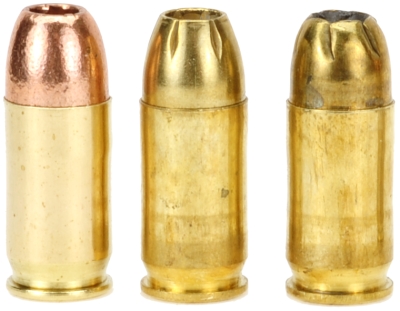
The 9mm Luger… Also fun, if spoken with a German accent
Warning: Bullet selections are specific, and loads are not valid with substitutions of different bullets of the same weight. Variations in bullet length will alter net case capacity, pressure and velocity. Primer selection is specific and primer types are not interchangeable. These are maximum loads in my firearms and may be excessive in others. All loads should be reduced by 5% as a starting point for development where cartridges have greater than 40 grains in capacity and 10% for cartridges with less than 40 grain capacity following safe handloading practices as represented in established mainstream reloading manuals. Presentation of these loads does not constitute a solicitation for their use, nor a recommendation.

| 9mm Luger Max 35.0 kpsi MAP |
|
| Firearm | Ruger LC9 Conversion |
| Barrel Length | 3.12″ |
| Max Case Length | 0.754″ +0.000″/-0.010″ |
| Min – Max COL | 1.000″ – 1.169″ |
| Primer | CCI 500 – Small Pistol |
| Bullet Diameter | 0.3555″ +0.000″/-0.0030″ |
| Reloading Dies | Lee Precision |
| Bullet Type | Bullet Weight Grains |
Net H2O Grains Capacity |
COL” | Powder Type | Powder Charge Grains |
Muzzle Velocity fps |
Muzzle Energy ft/lbs |
| Sierra JHP | 115 | 8.9 | 1.075 | Power Pistol | 6.5 | 1186 | 359 |
| Sierra JHP | 115 | 8.9 | 1.075 | CFE Pistol | 5.8 | 1141 | 333 |
| Remington JHP | 124 | 7.2 | 1.060 | AA 7 | 7.9 | 1150 | 364 |
| Remington JHP | 124 | 7.2 | 1.060 | CFE Pistol | 5.3 | 1042 | 299 |
| Hornady XTP | 147 | 6.2 | 1.100 | Power Pistol | 5.1 | 926 | 280 |
| Hornady XTP | 147 | 6.2 | 1.100 | Long Shot | 4.7 | 931 | 283 |
Assembling ammo was much easier, as the 9mm Luger casings are large enough to optically resolve without using binoculars at the bench. Changing to the 9mm kit for the LC380 was more than a subtle step up in power. Velocity was increased substantially, accuracy remained, functional reliability was also 100%, but the little pistol’s personality definitely changed. The 9mm Luger has a SAAMI test barrel length of 4″, which left the 3.12″ barrel showing a touch of muzzle blast and a bit of a bark.
The biggest pick up in the change to 9mm Luger is reliably increased penetration, 15″ to 20″, greater bullet mass for increase expansion and a significantly larger wound channel. The higher level of subcompact pistol performance places more responsibility on the shooter to perform. Practice, practice, etc.
The LC380CA with 9mm Luger conversion in place is not high in recoil or muzzle jump. It did, however, tend to slap at the palm of my hand as the day wore on, but not to the degree it posed a problem. Ruger has a soft slip on grip that would take care of the issue, but then I don’t see the LC380 / 9mm Luger conversion as multiple days at the range strictly punching holes in paper. Clearly, my wife will carry the LC380CA and I will convert it to 9mm Luger when it is with me.
As indicated in the LC380CA Part 1, built to include all California mandated features, the pistol is hammer fired rather than a cost reduced striker design and the steel sight set is dovetail mounted for adjustment and interchangeability with other Ruger and aftermarket sights. The MSRP is $539 and they are not usually on the shelf, new or used for very long. New pistols tend to stay close to that price, used are… negotiable.
To turn the LC380CA California roster pistol into a 9mm Luger version requires a kit with an MSRP of $299; slide, barrel, guide rod and recoil springs, plus a magazine. They are available from Ruger’s online Shop Ruger, as well as through other Ruger retail outlets. With kit in hand, the LC380CA can be tailored to a variety of shooters and a variety of situations.Nice pistol and a well considered conversion.

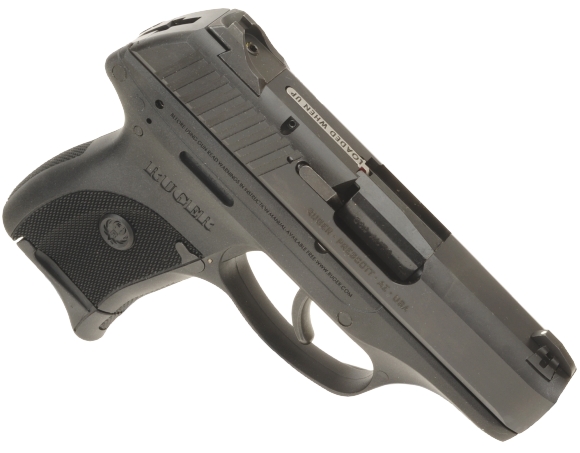
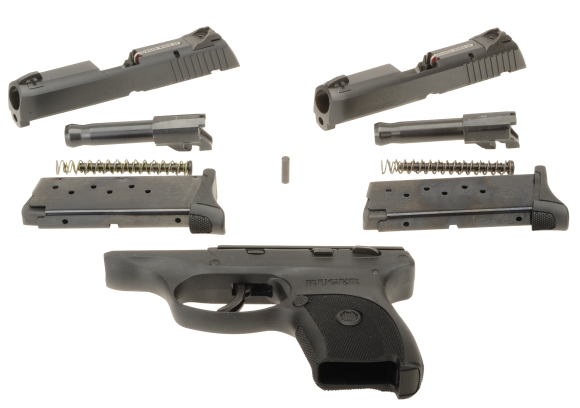

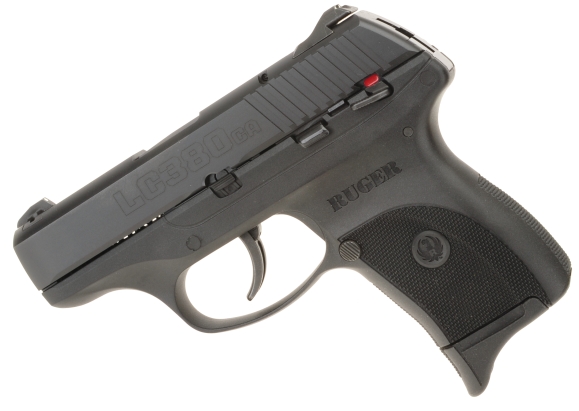
Email Notification